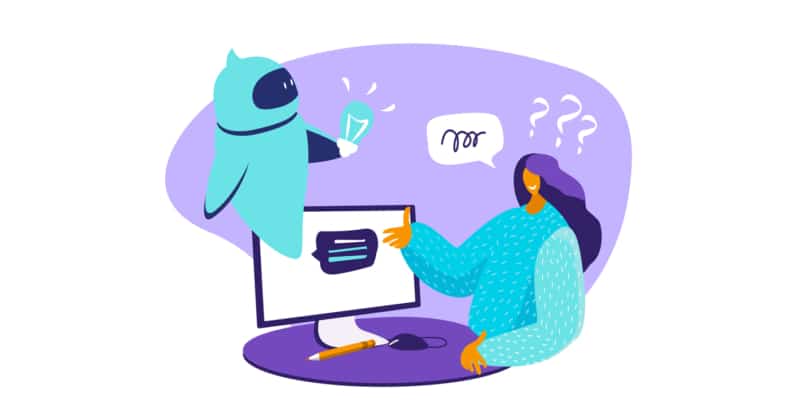Chatbots have been around for a few years now. While many use them for support purposes, it’s possible to incorporate them into your sales cycle. Using a chatbot for sales, you’ll be able to integrate multichannel sales solutions into a single funnel.
In this article, we’ll discuss the pros and methods of leveraging a chatbot for sales.
What are Chatbots?
Before we start, let’s explore the world of chatbots.
In short, a chatbot is a piece of software that interacts with humans in a conversational format, be it via chat or voice. It enables businesses to communicate with their audiences instantaneously and in a personalised way without compromise. Understandably, this provides a whole range of benefits to the company.
“Call centres, websites, and mobile apps are no longer the only means of interaction with brands. Chatbots are fast becoming a business imperative for businesses that want to engage with their customers. Online chat through chatbots has grown faster than any prior channel.”
As a side note, while many believe that chatbots require the use of AI, this is a myth.
Sure, chatbots can use natural language processing (NLP), a linguistically oriented subdomain of AI. In fact, the use of AI in sales and other business domains is quite widespread. However, many of the bots currently out there are rule-based, operating on if-this-then-that logic and branch out much like a traditional decision tree.
Don’t be fooled though, lack of AI doesn’t signify lesser capabilities. Which chatbot you decide to use highly depends on the use case. If you need to lead users down through a series of steps, a rule-based structure can be a great benefit. And so is the case with chatbots for sales!
Do Chatbots Increase Sales?
Yes, chatbots can play a significant role in increasing sales.
A recent Intercom study reported that the sales function was the most popular for chatbots, accounting for an impressive 41% of use cases. It was closely followed by customer support at 37% and marketing at 17%.
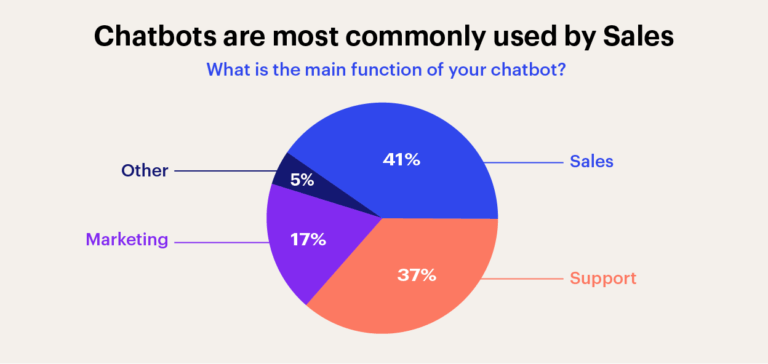
The same study, which interviewed a random sample of 500 consumers and 500 business leaders, showed chatbots increased sales 67% on average. More interestingly, the research revealed that 26% of all sales started via a chatbot interaction and 35% of business leaders claimed chatbots aided them close sales deals.
The Benefits of Chatbots
Before we look at the different ways you can use a chatbot in a sales funnel, let’s look at the more fundamental benefits of using a chatbot.
Chatbot Integrations
One of the beauties of chatbots is their ability to integrate with multiple platforms and tools. Therefore, sales tasks for which you’ve used numerous tools or needed human interference can be tied together with a chatbot.
On the one hand, you can integrate the same bot into different channels ranging from the web, to branded, social, or messaging apps. On the other hand, you can connect that bot with a range of “back-office” tools you are already using. Imagine integrating it with your CRM system, Airable database, or an email validator system!
24/7 Presence
Unless you’re a local business, your customers will likely come from multiple time zones.
While it’s possible to have customer support in multiple locations or through an agency, this is nearly never cost-effective. However, since chatbots are just code, they can be online 24/7. In other words, they can continuously collect data, offer information, and qualify and score your leads. When your sales agents are back online, they can happily review a list of sales leads your bot already ranked by their scores!
Immediacy and Consistency
Most questions posed towards sales agents are straightforward and easy to answer. However, when relying solely on your human team to answer them, the response time drags out. The simpler the query, the smaller the patience of your potential customer!
The other issue is consistency. There’s nothing as annoying as different agents giving you different answers, such as varying pricing or conditions information. Such occurrences can strongly affect your trustworthiness in the eyes of the potential customer.
Chatbots can address both issues. First, by providing answers to simple questions instantly and in conversational (easily understandable) language. Second, by working with the same pool/database of information, so each lead receives the same answers (or answers pertinent to their case!).
Lead Qualification & Targeted Bot-to-Human Handoff
Lead qualification makes up an essential part of the sales team’s workload and if not automated, it can be a real nightmare.
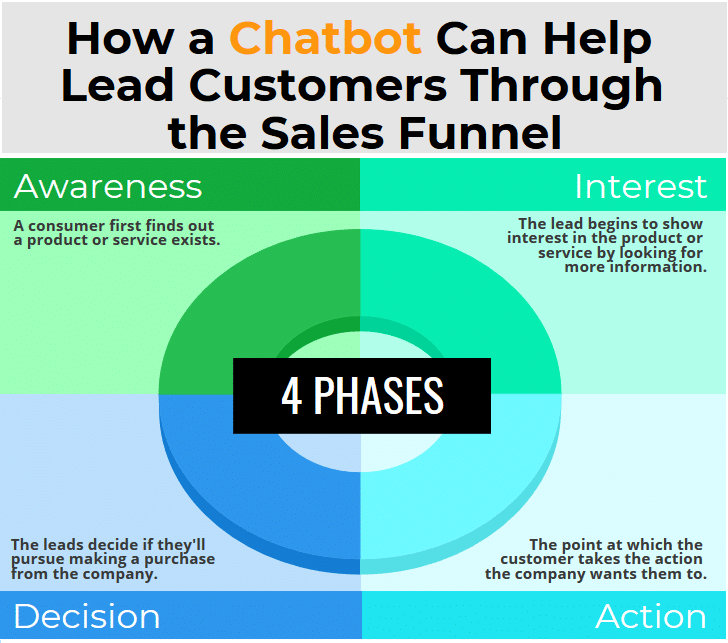
The most common way of qualifying leads is by using static forms, but those are quite limited in terms of the number of fields people are actually willing to fill out. Chatbot assistants prove very helpful in this scenario as, if set up correctly, they can qualify and score leads in real-time – no need to wait for the lead to press “Submit”.
In this context, chatbots can easily transfer the top-scoring leads to a live chat with your agent or offer them the opportunity to book a meeting with a Calendly integration.
Cost Saving
If it wasn’t evident from the previous three points, chatbots could help entire teams run more efficiently.
A more efficient team means that you get a better return on your investment (ROI) in the long-term. Furthermore, you’ll save money in the short-term as you won’t have to hire more employees to deal with menial tasks that a bot can do.
Handling Transactions
In some cases, chatbots can handle the full end-to-end of turning leads into customers. That is to say, they can generate interest, raise awareness, help prospects make a decision, and then complete the purchase.
Even if they manage to close just a small percentage of overall sales, think how amazing that is: a one-time setup leading to constant monthly sales! It’s an inbound marketer’s dream.
Using a Chatbot in a Sales Funnel
Every good sales funnel boasts multiple steps and stages that create a cycle more than just a one-way funnel (in the best-case scenario).
Generally, a sales journey breaks down into four core stages: awareness, interest, decision, and action.
This section will explore how a chatbot for sales can affect and aid in each of these stages.
Awareness
Raising awareness is the first and one of the most crucial steps in any sales cycle.
The more consumers are aware of your product and brand, the more likely they are to buy from you. For example, if you were looking for a new computer, you are more likely to buy a Dell or an Apple than NoNameBrand.
Chatbots can play an essential role in increasing brand awareness.
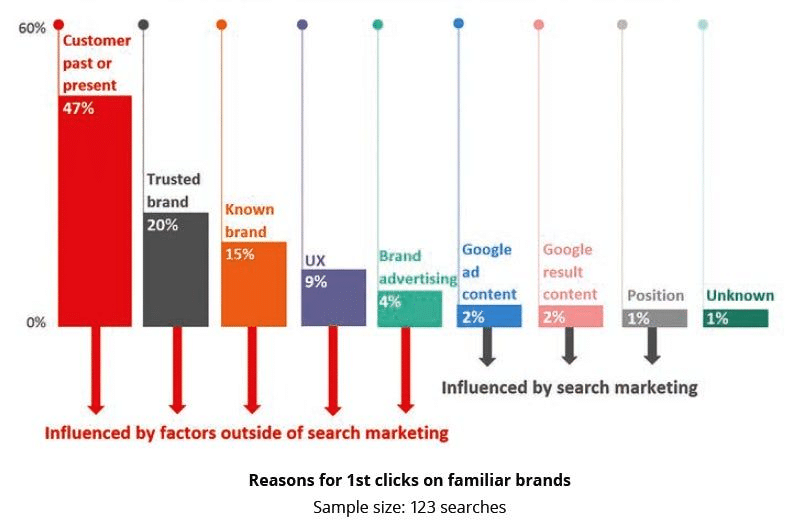
Besides serving the apparent purpose of providing information on a variety of chat-friendly channels, they are great tools for:
- Delivering custom content on demand
- Product marketing activities (e.g., online contests)
- Serving for interactive webinar promo, registration, and support
- Deploying interactive campaigns (e.g. banner bots, conversational landing pages, etc.)
- Creating experiences that go viral
Interest
When a person is aware of your product or service, they are likely to crave more information. Of course, your website design and content should already be able to help answer their questions and offer to solve their pain points.
Unfortunately, it’s impossible to answer all questions on your website. Well, even if you do manage it, the truth is, most people don’t bother reading much.
In these instances, a chatbot can be a great help.
As discussed under chatbot advantages, a chatbot can help answer additional questions even outside of office hours. Furthermore, it can offer up relevant supporting content in the form of videos, case studies, and more, at a moment’s notice.
For instance, a bot can ask the customer about their specific needs and questions, and curate content which is likely to answer them. That way, your prospects can learn more before they are ready to meet with your salespeople, or have something to do while they wait to connect with one.
More interestingly, if they interact with the bot on a messaging channel such as Messenger or WhatsApp, you gain the unique advantage of asynchronicity. In other words, your prospects will have the freedom to interact, read, and reply when it’s convenient to them, and the conversation won’t be limited to a single web-based exchange!
Decision
The customer is now ready to make their decision. At this stage, they might be considering two or three possibilities, including you (hopefully).
Your job is to turn that decision into action, because it isn’t final until they click the checkout button.
Often, when the customer is close to making the final decision, a small additional push can come in handy. Previously, this was done using pop-ups and various sales techniques.
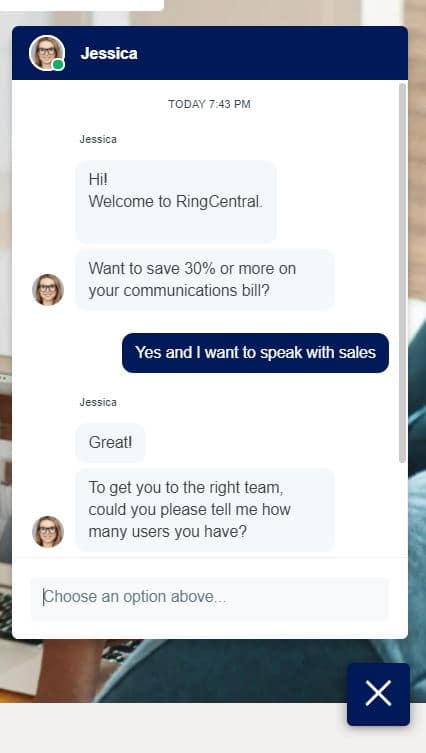
With a chatbot, you can give visitors a gentle nudge and answer any last queries they may have. Additionally, you can give them some final information on how the product will improve their lives. Alternatively, you can provide them with some discount or post-purchase offer to make sure they finalise the decision-making process. If you feel brave, you can use the bot to up or cross-sell, thereby increasing the individual’s customer value.
Action
As you very well know, this is the stage where and when the action takes place. After properly nurturing the prospect through the awareness, interest, and decision stages, you’re ready to seal the deal and convert. At last!
However, the goal isn’t just to get the almost-customers to buy. You should aim to set them up for success. After all, you want them to come back, no?
Once the person has become a customer, their journey doesn’t end there.
Here, too, you have a chance to leverage chatbots to do the hard follow-up for you! You can use a bot to provide your customers with educational materials to introduce and incorporate your product or service into their daily lives. A virtual assistant can provide additional (and immediate) support, recommend further purchases, and continually promote your brand.
A chatbot, if applied correctly, can be the perfect post-sale concierge ensuring the customers come back.
Chatbots in Action
Now that we’ve discussed chatbots, their pros and cons, and their uses, let’s look at some practical use cases!
Booking Appointments
As mentioned, chatbots can help customers through all stages of their lifecycle. For businesses that require in-person meetings, this includes making appointments.
By integrating with a calendar application such as Calendly, you can easily set up a chatbot to schedule appointments.
For example, at the start of the chatbot revolution, Sephora integrated a booking system into their chatbot. With this in place, they experienced an 11% rise in conversion rates. (That’s not bad if you ask me.)
End-to-End Customer Journey
The Pizza Hut Bot is a perfect example of meeting the end-to-end journey.
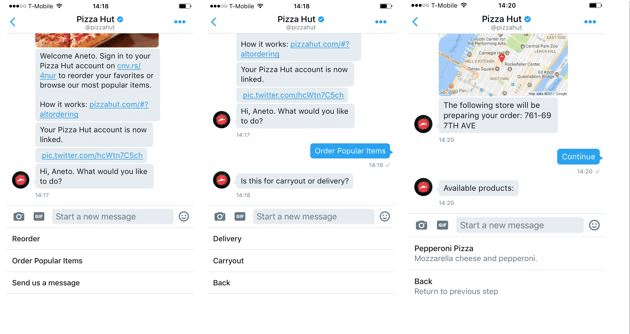
As expected, it can raise interest and awareness through pop-up messages and follow the user through their website and socials.
However, it can also integrate with your accounts and recommend reordering previous orders or new orders to make. Once your order is delivered, it requests feedback and improves your experience at the same time.
Owning Customer Happiness
It’s one thing to generate interest in and sell your product.
It’s an entirely different thing to ensure that customers are completely satisfied and enjoy your service.
American Express has done this fantastically on multiple levels. One of the services they have is the Amex Chatbot which allows customers to manage their accounts more easily. Alongside the simpler management, it also provides instant support. Plus, the number of features available is expected to increase over the coming years.
Conclusion
Overall, chatbots represent a deep well of opportunities for sales teams worldwide, and across all industries. Following the chatbot success in the face of a pandemic, 2021 will see more and more companies applying chatbot tech at various levels of complexity.
While it takes time and effort to set a bot up to perform correctly, no-code tools such as Landbot make it significantly faster and more intuitive! So much so, simpler bots take no more than a few minutes from concept to launch. While the more complex solutions might require a few days or a couple of weeks of creation, the benefits are definitely worth the effort!
Although you might be more used to the idea of bots in the customer support role, chatbots for sales have been gaining popularity, and deservedly so.
Originally published Mar 10, 2021, updated Jan 16, 2023
